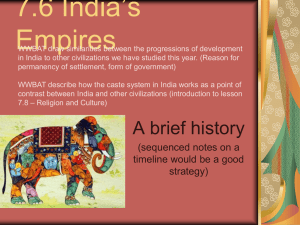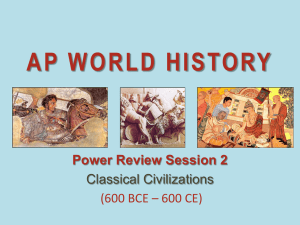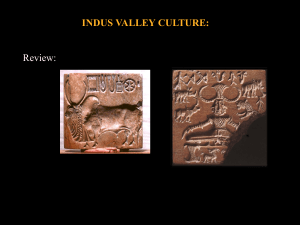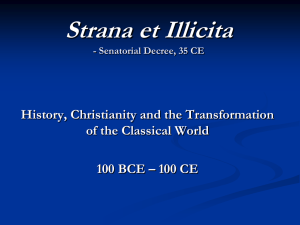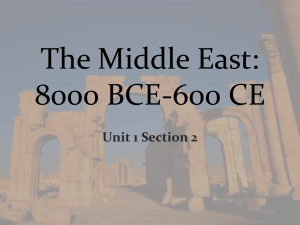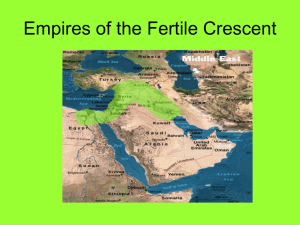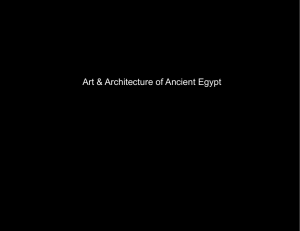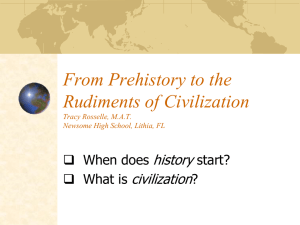Слайд 1 - English Studies
advertisement
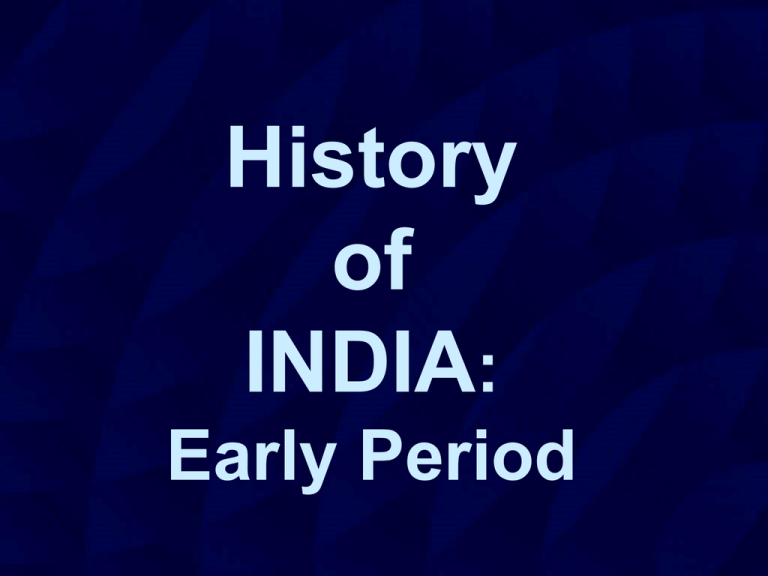
History of INDIA: Early Period History: periods 1 Prehistoric era 1.1 Stone Age 1.2 Bronze Age 2 Early historic period 2.1 Vedic period 2.2 Mahajanapadas 2.3 Maurya Empire 3 Early Middle Kingdoms — The Golden Age 3.1 Northwestern hybrid cultures 3.2 Kushan Empire 3.3 Gupta rule 4 Late Middle Kingdoms — The Late-Classical Age 5 The Islamic Sultanates 5.1 Delhi Sultanate 6 Early modern period 6.1 Mughal Empire 6.2 Post-Mughal period History: dates Stone age (7000–3000 BC) Bronze age (3000–1300 BC) Iron age (1200–26 BC) Classical period (1–1279 AD) Late medieval age (1206–1596 AD) Early modern period (1526–1858 AD) Stone Age Isolated remains of Homo erectus central India the Middle Pleistocene era (between 500,000 and 200,000 years ago) The earliest archaeological site in the Soan River valley the Paleolithic era (two million years ago) First tools by proto-humans in the northwestern part of India the Paleolithic era (two million years ago) More extensive settlement across the subcontinent in the Neolithic period, after the end of the last Ice Age (12,000 years ago) The first confirmed semipermanent settlements in the heart of India 9,000 years ago Early Neolithic culture Haryana, the Gulf of Khambat 7500 BCE Neolithic agriculture cultures in the Indus Valley region around 5000 BCE in the lower Gangetic valley around 3000 BCE in South India, spreading southwards/northwards around 1800 BCE Bronze Age • began around 3300 BCE with the early Indus Valley Civilization (IVC) • IVC was centered on the Indus River and its tributaries (occupying the Ghaggar-Hakra River valley, the Ganges-Yamuna Doab, Gujarat, and southeastern Afghanistan ) • IVC is primarily located in modern-day India (Gujarat, Haryana, Punjab and Rajasthan provinces) and Pakistan • IVC is the world's earliest urban civilizations, along with Mesopotamia and Ancient Egypt • The Mature Indus civilization flourished from about 2600 to 1900 BCE • urban centers: Dholavira, Kalibangan, Rupar, Rakhigarhi, and Lothal in modern-day India Harappa, Ganeriwala, and Mohenjo-daro in modern-day Pakistan • Inhabitants of the ancient IVC - the Harappans introduced new techniques in metallurgy and handicraft (carneol products, seal carving) produced copper, bronze, lead, and tin cities built of brick multistoried houses roadside drainage system Iron Age • • • • • • • • • • • Indo-Aryan culture is associated with the texts of Vedas The Vedas are sacred to Hindus, orally composed in Vedic Sanskrit. The Vedas are some of the oldest extant texts in the world The Vedas laid the foundations of Hinduism and other cultural aspects of early Indian society The Vedic period lasted from about 1500 to 500 BCE Early Vedic society consisted of largely pastoral groups Aryan society was socially organized around the four varnas, or social classes The later part - an increasing movement away from the previous tribal system towards the establishment of kingdoms, called mahajanapadas This period saw the second major rise of urbanism in India after the Indus Valley Civilization Many of the sixteen kingdoms had coalesced to four major ones by 500/400 BCE, - the time of Gautama Buddha The beginnings of Buddhism and Jainism Maurya Empire • ruled by Mauryan dynasty in 322–185 BCE • a geographically extensive and powerful political and military empire • established by Chandragupta Maurya in Magadha what is now Bihar • flourished under the reign of Ashoka the Great • Ashoka ruled the Maurya Empire for 37 years from 268 BCE until he died in 232 BCE • an active foreign policy aimed at setting up a unified state, which failed • was involved in a war with the state of Kalinga • slavery developed rapidly • Ashoka's reign propagated Buddhism Golden Age: Early Middle Kingdoms • The Satavahana dynasty (the Andhras) ruled in southern and central India after around 230 BCE. • Satakarni, the sixth ruler of the Satvahana dynasty, defeated the Sunga Empire of north India. • Kharavela, the king of Kalinga, ruled a vast empire and was responsible for the propagation of Jainism in the Indian subcontinent, started colonization in Sri Lanka, Burma, as well as the Maldives and Maritime Southeast Asia. • The Kuninda Kingdom was a small Himalayan state that survived from around the 2nd century BCE to the 3rd century CE. • The Kushanas migrated from Central Asia into northwestern India in the middle of the 1st century CE and founded an empire that stretched from Tajikistan to the middle Ganges. • The Western Satraps (35-405 CE) were Saka rulers of the western and central part of India. • The Kalabras, a Buddhist dynasty, briefly interrupted the usual domination of the Cholas, Cheras, and Pandyas in the south. • The northwestern hybrid cultures of the subcontinent included the IndoGreeks, the Indo-Scythians, the Indo-Parthians, and the Indo-Sassinids. The Classical Age • India reunited under the Gupta Empire (c. 320– 550 CE) • extensive achievements in science, technology, engineering, art, dialectic, literature, logic, mathematics, astronomy, religion, and philosophy • Strong political administration • Strong trade ties • the Guptas performed Vedic sacrifices to legitimize their rule • patronized Buddhism • fell under Hunas and the rise of other kingdoms Islamic Sultanates • Turks and Afghans - in the 12th and 13th centuries invaded parts of northern India and established the Delhi Sultanate in the former Rajput holdings • Under Slave dynasty – extended to the size of the Gupta Empire • Indian cultural renaissance • "Indo-Muslim" fusion of cultures left lasting syncretic monuments in architecture, music, literature, religion, and clothing • the language of Urdu (literally meaning "horde" or "camp") was born during the Delhi Sultanate period = as Sanskrit + Persian, Turk, and Arabic • Timur (Tamerlane) defeated the army of the reigning Sultan Nasir-u Din Mehmud of the Tughlaq Dynasty in Delhi • Delhi was sacked Mughal Empire • In 1526, Babur, a Timurid descendant established the Mughal Empire, covering modern day Afghanistan, Pakistan, India and Bangladesh • His son Humayun was forced to retreat to Kabul • a secular Hindu rule in North India from Delhi was established till 1556 • Babur’s grandson Akbar took over the city in 1556 • Akbar’s tolerant attitude to Hindus was followed by complete Muslim dominance imposed by his successors (Aurangzeb) • went into a slow decline after 1707 Lecture 4 History: from colonial times to the 21st century Presentation: The events that changed India out of recognition Discussion: Colonialism: a curse or a blessing?
